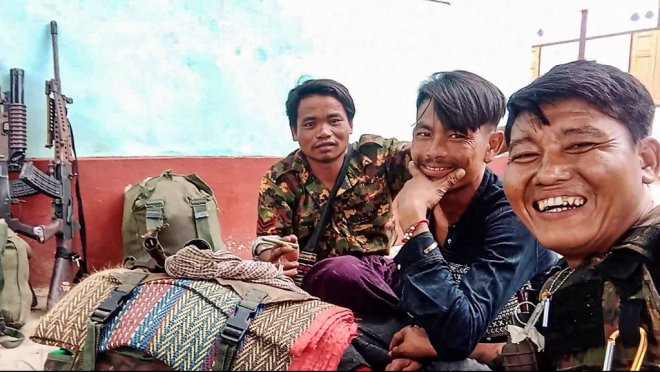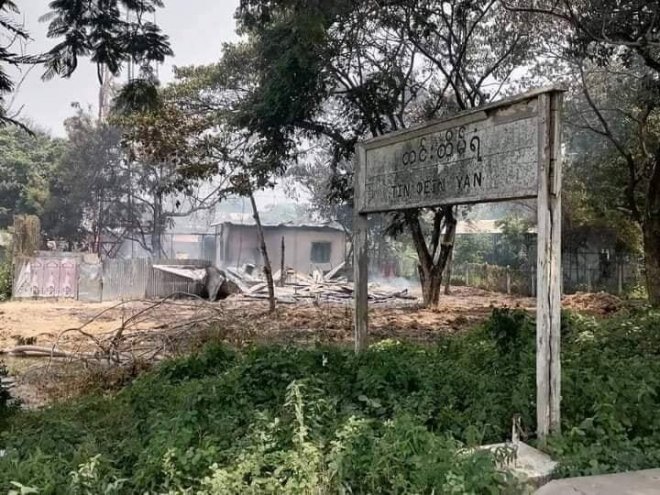
One year ago, horror visited the village of Mon Taing Pin.
Burmese junta troops killed 29 of the village’s menfolk, maiming and burning the bodies in a 44-hour orgy of violence that was recorded on a soldier’s cell phone.
Today, the villagers of this forsaken community in Myanmar’s northern war-torn Sagaing region still mourn their losses and live in perpetual fear of another military assault as the junta attempts to squelch resistance to its two-year-old military takeover.
“If the military comes from the south, we have to run to the north. If they come from the north, we have to run to the south,” said one 40-year-old woman, who lost both her husband and her brother in the May 10-12 attack.
“We are still panic-stricken,” she added. “I depended on my husband’s daily bread and now I don’t know what to do.” Like all the Mon Taing Pin residents cited in this report, the woman requested anonymity for safety reasons.
 In an image taken from a video found on a soldier’s phone, the phone’s owner and two other soldiers who appear to have taken part in the Mon Taing Pin massacre talk about how many people they have killed, the methods they used and cutting up the bodies.
In an image taken from a video found on a soldier’s phone, the phone’s owner and two other soldiers who appear to have taken part in the Mon Taing Pin massacre talk about how many people they have killed, the methods they used and cutting up the bodies.
Radio Free Asia revealed the massacre last June after analyzing a cache of files retrieved from a cell phone that was dropped in a neighboring township and found by a villager.
It included an image of about 30 men with their hands tied behind their backs on the grounds of a monastery, and victims of execution a day later.
Boasting about killings
Stoking further outrage, the phone included photos of armed men posing next to corpses, and a video in which they boast about how many people they have killed, and how they have killed them.
The photos and video indicated the presence of Light Infantry Battalion 708, which is part of the Yangon-based Military Operations Command No. 4. Witnesses also said members of the pro-junta Pyu Saw Htee militia took part in the raid on the village.
Ample proof of Burmese military atrocities and abuses by security forces has emerged in the past two years. There has been detailed testimony from victims and military defectors; images and footage from citizens’ cell phones; CCTV video; and satellite imagery analysis of dozens of villages in Sagaing burned to the ground.
But the Mon Taing Pin massacre appeared to be the first time in which Burmese soldiers had been caught on film talking about the horrors that they were visiting upon people. It was part of an ongoing scorched earth campaign that has terrorized this rural heartland of northern Myanmar since the Feb. 1, 2021, coup against a civilian government.
 A series of photos from April 28 on the soldier’s phone shows a young man with his arms bound behind him, his face puffy and bloodied while a person holds a knife to his chest. A witness to the massacre described a similar interrogation technique by the soldiers during the raid on Mon Taing Pin.
A series of photos from April 28 on the soldier’s phone shows a young man with his arms bound behind him, his face puffy and bloodied while a person holds a knife to his chest. A witness to the massacre described a similar interrogation technique by the soldiers during the raid on Mon Taing Pin.
In follow-up reporting, RFA has verified accounts of what happened in the village by speaking to the people who lived there.
One woman said that she lost all three of her sons in the onslaught that began at around 6 a.m. on May 10 with heavy weapons fire. About 150 Burmese military and pro-junta militia entered the village with guns blazing. The attack ended around 2 a.m. on May 12, as soldiers left after slaughtering the men they had detained.
Most of Mon Taing Pin’s survivors returned to their homes within a couple of days of the attack, and they continue to eke out a fragile existence. Residents say the last time junta troops came to the village was March 5 this year.
Junta target
The surrounding Ye-U township has become a frequent target for junta forces. Since the coup, some 3,332 homes in 53 villages have been burned down there, according to the residents and local militia.
Across the whole of Sagaing, nearly 48,000 houses have been burned as of the end of February 2023, according to the non-government research group, Data for Myanmar. That’s out of a total of about 60,500 houses burned nationwide.
“For three months after the incident, they raided the village every month,” said a 64-year old man who lives in Mon Taing Pin. “Now, they have left for the southern part of Tabayin,” he added, referring to the township to the southwest of Ye-U.
 The charred remains of Tin Tein Yan village in Sagaing region"s Ye-U township, which was attacked by junta forces, Aug. 2022. Credit: Ye-U township"s People"s Defense Group
The charred remains of Tin Tein Yan village in Sagaing region"s Ye-U township, which was attacked by junta forces, Aug. 2022. Credit: Ye-U township"s People"s Defense Group
He said that villagers have struggled to grow new crops this year and have to share what they have with neighbors. There are about 400 households in Mon Taing Pin, and a total of about 1,800 people. Some 30 houses were burned down during the violence, and charred bodies were found inside the burned homes.
One mother, whose 34-year-old son Kyaw Min Aung was among those slain, said she constantly thinks about his killing. Whenever she misses her son, she grasps the long-sleeved checkered shirt and hat he was wearing on May 11 – the day he died.
“Now it is the anniversary. My heart is broken. I cannot forget [my son] for a single day,” she said.
Myanmar’s military, however, appears to have done just that.
When junta spokesman Maj. Gen. Zaw Min Tun spoke to RFA about events in Mon Taing Pin last June, he said that authorities had opened a probe into the matter. “Regarding these incidents, we can respond only after investigation in the field,” he said.
Since then, RFA has repeatedly sought an update from the spokesman, including for this report. He did not pick up a reporter’s calls.
Allegations of atrocities and war crimes by junta forces have piled up since the Mon Taing Pin massacre. In the deadliest reported incident since the coup, as many as 200 people were killed in an April 11 air strike on Pa Zi Gyi village in Sagaing’s Kanbalu township.
‘Evil’ military dictatorship
In Mon Taing Pin, grief now mingles with defiance.
“What I want to say is that this evil of military dictatorship must be rooted out,” the male resident said. “We can cure our loss if the junta is toppled. So, we must revolt until the military dictatorship is eliminated.”
 This photo (blurred to cover the graphic scene) shows the phone owner and a man who also appeared in the video standing next to five slain men lying in pools of blood. Two of the slain men also can be seen in the photo from the previous day showing about 30 men with their hands tied behind their backs on the grounds of Mon Taing Pin monastery.
This photo (blurred to cover the graphic scene) shows the phone owner and a man who also appeared in the video standing next to five slain men lying in pools of blood. Two of the slain men also can be seen in the photo from the previous day showing about 30 men with their hands tied behind their backs on the grounds of Mon Taing Pin monastery.
Myint Htwe, who was an elected parliamentarian representing Ye-U township before the coup, said it was “vital” to persecute the perpetrators by courts martial for what was a violation of military conduct and international law.
“After the revolution, the perpetrators must be held to account for their role in overseeing or carrying out the killing. Everyone knows it,” he said.
The woman who lost her husband and brother in the massacre also demanded justice.
“There was a mass killing. There are widows who lost their husbands. Some lost two or three sons. They have been suffering from mental disorders,” she told RFA.
“We are the same. Husbands and brothers were burned alive and that caused deep resentment,” she said. “We want justice for those victims and their families.”
Edited by Mat Pennington.
